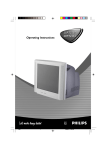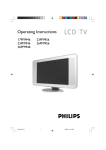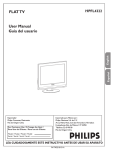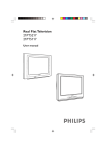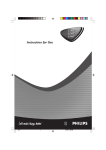Download Philips 20" LCD Flat TV with Crystal Clear III 20" Black
Transcript
English www.philips.com/support Country Austria Belgium Czech Rep Denmark Finland France Germany Greece Hungary Ireland Italy Luxemburg Netherlands Norway Poland Portugal Slovakia Spain Sweden Switzerland UK Number 0810 000205 078250145 800142840 3525 8759 09 2311 3415 0821 611655 0900 1101211 0 0800 3122 1280 0680018189 01 601 1777 840320086 40 6661 5644 0900 8407 2270 8111 0223491504 2 1359 1442 0800004537 902 888 784 08 5792 9100 0844 800 544 0845 601 0354 This information is correct at the time of press. For updated information, see www.support.philips.com Model Serial Tariff €0.07/min €0.06/min free local local €0.09/min €0.10/min free free local €0.08/min local €0.10/min local local local free €0.10/min local local local Information for users in the UK (not applicable outside the UK) Positioning the TV Important For the best results, choose a position where light does not fall directly on the screen, and at some distance away from radiators or other sources of heat. Leave a space of at least 5 cm all around the TV for ventilation, making sure that curtains, cupboards etc. cannot obstruct the air flow through the ventilation apertures.The TV is intended for use in a domestic environment only and should never be operated or stored in excessively hot or humid atmospheres. This apparatus is fitted with an approved moulded 13AMP plug. Should it become necessary to replace the mains fuse, this must be replaced with a fuse of the same value as indicated on the plug. General Points 3 Refit the fuse cover. If for any reason the fitted plug is not suitable for your socket outlet, please consult your retailer or a qualified electrician before proceeding with the installation. Please take note of the section entitled ‘Tips’ at the end of this booklet. Interference The Department of Trade and Industry operates a Radio Interference Investigation Service to help TV licence holders improve reception of BBC and IBA programmes where they are being spoilt by interference. If your dealer cannot help, ask at a main Post Office for the booklet “How to Improve Television and Radio Reception”. Mains connection Before connecting the TV to the mains, check that the mains supply voltage corresponds to the voltage printed on the type plate on the rear panel of the TV. If the mains voltage is different, consult your dealer. 1 Remove fuse cover and fuse. 2 The replacement fuse must comply with BS 1362 and have the ASTA approval mark. If the fuse is lost, make contact with your retailer in order to verify the correct type. Connecting the aerial The aerial should be connected to the socket marked : at the back of the set. An inferior aerial is likely to result in a poor, perhaps unstable picture with ghost images and lack of contrast. Make-shift loft or set-top aerials are often inadequate.Your dealer will know from experience the most suitable type for your locality. Should you wish to use the set in conjunction with other equipment, which connects to the aerial socket such as TV games, or a video camera it is recommended that these be connected via a combiner unit to avoid repeated connection and disconnection of the aerial plug. Fitting the stand (if provided) Use only the stand provided with the set, making sure that the fixings are properly tightened. A diagram showing how to assemble the stand is packed with the stand. Never use a make-shift stand, or legs fixed with woodscrews. English Recycling The packaging of this product is intended to be recycled. Apply to the local authorities for correct disposal. Product information • This TV consumes minimal energy in standby mode to minimise environmental impact Disposal of your old product Your product is designed and manufactured with highly quality material and components, which can be recycled and reused. When this crossedout wheeled bin symbol is attached to a product, it means the product is covered by the European Directive 2002/96/EC. Please inform yourself about the local separate collection system for electrical and electronic products. Please act according to your local rules and do not dispose your old products with your normal household waste. The correct disposal of your old product will help prevent potential negative consequences for the environment and human health. Disposal of batteries The batteries supplied do not contain the heavy metals mercury and cadmium. Please check on how to dispose exhausted batteries according to local regulations. 2 Rear of TV • Standby Power Consumption for this set is less than 2 W. • Power Consumption of the set can found on the type plate at the rear of the TV. • For more specifications of the product see the product leaflet on www.philips.com/support. Note Specifications and information are subject to change without notice. • If you need further assistance, please call the customer support service in your country. The corresponding telephone numbers and addresses are given in the supplied Worldwide guarantee booklet. English Introduction Thank you for purchasing this television set. This handbook has been designed to help you install and operate your TV set. We strongly recommend that you read it thoroughly. Safety Information. . . . . . . . . . . . . . . . . . . . . . . . . . . . . . . . . . . . . . . . . . . . . . . . . . . . . . . . . . . . . . 2 Preparation / Getting started . . . . . . . . . . . . . . . . . . . . . . . . . . . . . . . . . . . . . . . . . . . . . . . . . . . . . 3 Television keys and connectors . . . . . . . . . . . . . . . . . . . . . . . . . . . . . . . . . . . . . . . . . . . . . . . . . . . 4 Remote Control keys . . . . . . . . . . . . . . . . . . . . . . . . . . . . . . . . . . . . . . . . . . . . . . . . . . . . . . . . . . . 5 Quick installation . . . . . . . . . . . . . . . . . . . . . . . . . . . . . . . . . . . . . . . . . . . . . . . . . . . . . . . . . . . . . . 6 Programme sort . . . . . . . . . . . . . . . . . . . . . . . . . . . . . . . . . . . . . . . . . . . . . . . . . . . . . . . . . . . . . . . 6 Auto store . . . . . . . . . . . . . . . . . . . . . . . . . . . . . . . . . . . . . . . . . . . . . . . . . . . . . . . . . . . . . . . . . . . 7 Manual store . . . . . . . . . . . . . . . . . . . . . . . . . . . . . . . . . . . . . . . . . . . . . . . . . . . . . . . . . . . . . . . . . . 7 Naming channels . . . . . . . . . . . . . . . . . . . . . . . . . . . . . . . . . . . . . . . . . . . . . . . . . . . . . . . . . . . . . . . 8 Picture and sound settings . . . . . . . . . . . . . . . . . . . . . . . . . . . . . . . . . . . . . . . . . . . . . . . . . . . . . . . 8 Using the Contrast+ and Sleeptimer features . . . . . . . . . . . . . . . . . . . . . . . . . . . . . . . . . . . . . . . . 9 Using the smart picture and sound features . . . . . . . . . . . . . . . . . . . . . . . . . . . . . . . . . . . . . . . . . 9 Screen formats . . . . . . . . . . . . . . . . . . . . . . . . . . . . . . . . . . . . . . . . . . . . . . . . . . . . . . . . . . . . . . . 10 Teletext . . . . . . . . . . . . . . . . . . . . . . . . . . . . . . . . . . . . . . . . . . . . . . . . . . . . . . . . . . . . . . . . . . . . . 11 Using the TV as a PC monitor . . . . . . . . . . . . . . . . . . . . . . . . . . . . . . . . . . . . . . . . . . . . . . . . . . . 12 Using the TV in High Definition (HD) mode . . . . . . . . . . . . . . . . . . . . . . . . . . . . . . . . . . . . . . . 13 Using the TV as an FM Radio . . . . . . . . . . . . . . . . . . . . . . . . . . . . . . . . . . . . . . . . . . . . . . . . . . . . 14 Using the FM radio sound features . . . . . . . . . . . . . . . . . . . . . . . . . . . . . . . . . . . . . . . . . . . . . . . 15 Connecting peripheral equipment Connecting a DVD recorder or VCR recorder . . . . . . . . . . . . . . . . . . . . . . . . . . . . . . . . . . . . . 16 Connecting a computer . . . . . . . . . . . . . . . . . . . . . . . . . . . . . . . . . . . . . . . . . . . . . . . . . . . . . . . . 17 Connecting HD equipment . . . . . . . . . . . . . . . . . . . . . . . . . . . . . . . . . . . . . . . . . . . . . . . . . . . . . 18 Connecting other equipment (satellite, decoder, game console, etc . . . . . . . . . . . . . . . . . . . . . 19 Connecting a camera, camcorder or headphones . . . . . . . . . . . . . . . . . . . . . . . . . . . . . . . . . . . 19 Troubleshooting tips . . . . . . . . . . . . . . . . . . . . . . . . . . . . . . . . . . . . . . . . . . . . . . . . . . . . . . . . . . 20 Glossary . . . . . . . . . . . . . . . . . . . . . . . . . . . . . . . . . . . . . . . . . . . . . . . . . . . . . . . . . . . . . . . . . . . . 21 1 English Safety Information X X Do not connect too much equipment to the same mains socket because it can result in fire or electric shock. X X X X • When cleaning the surface or the screen of the set, wipe gently with absorbent cotton or cloth or other soft material like chamois. Do not use a cloth which is dripping with water. Do not use acetone, toulene or alcohol to clean the TV. As a safety precaution, unplug the power cord from the mains. • As a safety precaution, do not touch any part of the TV, power lead or aerial lead during lightning storms. X Do not expose the TV or the batteries of the remote control to heat, direct sunlight, rain or water. X • Do not place naked flame sources such as lighted candles close to the TV set. • Do not place a vase filled with water near the TV. Spilling water into the TV can result in electric shock. Do not operate the TV if water is spilled into the set. Unplug the power cord from the mains immediately and have the set checked by a qualified technician. To connect to the mains, insert the appliance coupler into the mains socket at the back of the TV and the plug into the wall socket. To disconnect from the mains, remove the appliance coupler from the mains socket at the back of the TV or remove the plug from the wall socket. The appliance coupler or the mains cord on the TV is used as the disconnect device. X Pull the power lead by the plug. Do not pull on the power lead. Do not use a poor fitting mains socket. Insert the plug fully into the mains. If it is loose, it may cause arching and result in fire. Electric, Magnetic and Electromagnetic Fields (“EMF”) • Philips Royal Electronics manufactures and sells many products targeted at consumers, which, like any electronic apparatus, in general have the ability to emit and receive electro magnetic signals. • One of Philips’ leading Business Principles is to take all necessary health and safety measures for our products, to comply with all applicable legal requirements and to stay well within the EMF standards applicable at the time of producing the products. 2 • Philips is committed to develop, produce and market products that cause no adverse health effects. • Philips confirms that if its products are handled properly for their intended use, they are safe to use according to scientific evidence available today. • Philips plays an active role in the development of international EMF and safety standards, enabling Philips to anticipate further developments in standardisation for early integration in its products. English Preparation / Getting started 1 2 3 4 5121 15PF 5121 20PF 5321 23PF Do not remove the protective sheet until you have completed the stand/wallmounting and connections. Please handle with care. Use a soft cloth provided to clean the glossy black front of the TV. 1 Positioning the TV set • If you place the TV set on a surface, ensure the surface is level and that it can withstand the weight of the TV. • Before you hang your TV on a wall, ensure the wall is suitable to carry the weight of the TV. Installation of the TV set on the wall should be carried out by qualified person. Improper installation can cause the TV to be unsafe. • The connections do not have to be made before hanging the TV, but the cables must be inserted into connectors of the TV. • Wherever you place or hang the TV, ensure that air can circulate freely through the ventilation slots. Do not position the TV in a confined space. • The power consumption of the set is given on the type plate at the rear of the TV. Warning: Verify that the mains supply voltage in your home corresponds to the voltage printed on the sticker at the rear of the TV. If the TV is mounted on a swivel base or swivel arm, ensure no strain is placed on the power cord when the TV is swivelled. Strain on the power cord can loosen connections. This may cause arcing and result in fire. 3 Using the Remote Control • Insert the 2 batteries supplied. Ensure that the (+) and (-) ends of the batteries line up correctly (inside of case is marked.) 4 Switching on the TV set 2 Connections If you do not have a cable box or satellite box, follow these instructions: • Insert the aerial plug into the : socket at the bottom of the set. • Insert the mains plug into a wall socket (220-240V 50/60Hz). If you are using a cable box or satellite box see “Connecting peripheral equipment” on page 16 to 19. • To switch on the TV set, press the POWER button. A green indicator comes on and the screen lights up. • If the TV set remains in standby mode (red indicator), press the P – / + button on the remote control. NOTE: Do not leave the TV in standby mode for an extended period of time. Instead, disconnect the TV from the mains. 3 English Television keys and connectors 1 2 3 4 11 R AUDIO IN L VIDEO IN S-VIDEO DVI AUDIO IN TV 75Ω : FM ANT 6 7 EXT1 DVI-I (HD/PC) 5 8 10 1 POWER : to switch the TV on or off. Note : The power remains on even when the POWER switch is turned off. 7 FM Aerial socket : Insert the radio aerial lead into the FM Antenna socket. 8 For Service use only. 2 PROGRAM – / + : to select programmes. 5 POWER socket : Insert the mains plug into a wall socket. 9 EXT1 socket : for connecting to devices like DVD, VCR, recorder, decoder or games console. 10 DVI-I (HD / PC) : for connecting a High Definition (HD) equipment or computer with DVI/VGA output. 11 Side connections (AV/SVHS) : for connecting to devices like camera or camcorder. Also allows you to connect your headphone for your personal listening pleasure. 6 TV Aerial socket : Insert the aerial plug into the TV Antenna socket. For more information about connections, see page 16 to 19. 3 MENU : to access or close menus. The PROGRAM – / + keys can be used to select a menu item and the VOLUME – / + keys to enter into the selected menu item and make adjustments. 4 VOLUME – / +: to adjust sound level. 4 9 English Remote Control keys 1 5 Screen Format 6 MENU 11 12 2 To call up or exit the TV menus. 7 3 (see page 10). Cursors To select and adjust the menu items. 4 13 5 8 Volume ( – VOL + ) To adjust the sound level. 6 9 14 7 15 8 16 9 17 10 18 Smart Picture / Sound To access a series of predefined picture and sound setting (see page 9). 10 Screen information To display/remove the programme number, the sound mode and the remaining time of the sleeptimer. 11 Sound mode To force programmes in Stereo and Nicam Stereo to Mono or, for bilingual programmes, to choose between Dual å or Dual ». The Mono indication is red when in forced position. 12 Programme List To display / exit the list of programmes. Use the Î ï keys to select a programme and the Æ key to display it. 13 Teletext key (see page 11). 14 Surround mode To activate / deactivate the surround sound effect. In stereo, this gives the impression that the speakers are further apart. 1 Standby To set the TV to standby mode. To switch the TV set on again, press , to , P – / + (PROGRAM – / +) or AV key. 2 Sleeptimer To select a time period before the set switches to standby mode automatically (see page 9). 3 AV To display the Source List to select TV or peripheral equipment connected to EXT1, AV/SVHS, PC, HD or FM Radio. 4 Teletext keys (see page 11) 15 Mute Mute or restore sound. 16 Selecting TV programmes ( – P + ) To select the next or previous programme. The number and the sound mode are displayed for a few seconds. For some TV programmes, the title of the programme appears at the bottom of the screen. 17 / Numerical keys To access programmes directly. For a 2 digit programme number, the 2nd digit must be entered before the dash disappears. 18 Previous/Present programme To alternate between the last viewed and present programme. 5 English Quick Installation When you switch on the TV set for the first time, a menu is displayed on screen. This menu prompts you to select the country and language for the menus. Plug’n’Play Important : To exit or interrupt the search before it is completed, press the H key. If you interrupt search during auto store, not all channels are stored. For all channels to be stored, you need to do a complete auto store search again. Language Country Í GB Æ The search starts automatically. All the available TV programmes are stored. This operation takes a few minutes. The display shows the progress of the search and the number of programmes found. English Note If the above menu is not displayed, proceed to do the installation of channels by the Auto Store method (see page 7). If the above menu is displayed, proceed to do the following steps. & Use the Î ï keys on the remote control to select your country. If your country does not appear in the list, select “. . . “ . Refer to the “Reference table of Countries available for selection” on page 22. é Use the Æ key to move to the Language mode and select your language with the Î ï keys. “ Use the Æ key to start search. Note ATS (Automatic Tuning System) feature If the transmitter or cable network sends the automatic sort signal, the programmes are numbered correctly. In this case, the installation is complete. If this is not the case, you can use the Sort menu to number the programmes correctly. ACI (Automatic Channel Installation) feature If a cable system or a TV channel which broadcasts ACI is detected, a programme list appears. Without ACI broadcast, the channels are numbered according to your language and country selection. You can use the Sort menu to re-number them. Some transmitters or cable networks broadcast their own sort parameters (region, language, etc.). In this case, indicate your choice using the Î ï keys and confirm with Æ key. Programme Sort 1 Press the H key. The TV Menu is displayed on the screen. TV Menu Picture Sound Features Install 3 Use the ï key to select Sort and the Æ key to enter sort mode. 4 Select the programme number you want to move by using the Î ï keys and the Æ key to enter sorting mode. (The arrow cursor now points to the left.) Install Language Country Auto Store Manual Store Sort Name Æ • 0 Æ Æ Æ Æ Æ • • • • • 1 2 3 4 5 Æ 2 Use the ï key, select the Install menu and the Æ key to enter the Install menu. 6 5 Use the Î ï keys to select the new programme number and confirm with the Í key. (The arrow points to the right and sorting is completed.) 6 Repeat steps 4 and 5 for each programme number you wish to re-number. 7 To exit the menu, press the Ë key. 1 Press the H key. 2 Using the ï key, select Install and the Æ key to enter the Install menu (Language is highligted). TV Menu Install Picture Sound Features Install Language Country Auto Store Manual Store Sort Name Í English 6 To exit the menu, press the Ë English Auto Store key. NOTE : If you interrupt search during auto store, not all channels are stored. For all channels to be stored, you must do a complete auto store search again. Æ Æ Æ Æ Æ * Selecting the language If you have selected the wrong language to operate the set, take the following steps to bring you back to your preferred language : Æ 3 Before you proceed to auto store channels, select your desired menu *Language with the Í Æ keys. 4 Select Country with the ï key and use the Í Æ keys to select the country of your choice. 5 Using the ï key, select Auto Store. Use the Æ key to start automatic searching for channels. All the available TV programmes are stored. This operation takes a few minutes. The display shows the progress of the search and the number of programmes found. To exit or interrupt the search, press the H key. – Press the Ë key to exit the existing menu. – Press the H key to enter the TV menu. – Press the ï key repeatedly until the FOURTH item in the TV menu is highlighted. – Press the Æ key to go into the Install menu – Press the Í Æ keys to select your preferred language (the menu will now appear in the chosen language). You can proceed to install the TV channels automatically. Manual Store This menu is used to store the programmes one at a time. 1 Press the H key. 2 With the ï key, select Install and the Æ key to enter the Install menu. 3 Use the ï key to select Manual Store and the Æ key to enter Manual Store menu. 4 Use the Î ï keys to select the items in the Manual Store menu to adjust or activate. TV Menu Picture Sound Features Install 5 6 Search : Press the Æ key. The search starts. Once a programme is found, the scanning stops and its name is displayed (if available). Go to the next step. If you know the frequency of the required programme, you can enter it directly by using the to keys. If no picture is found, see “Troubleshooting Tips on page 20-21. 7 Program No. : Enter the required number by using the to or Í Æ keys. 8 Fine Tune : If the reception is not satisfactory, adjust it by using the Í Æ keys. 9 Store : To store the changes, press the Æ key . The programme is now stored. Manual Store System Search Program No. Fine Tune Store Europe Æ Æ Æ Æ System : Use the Í Æ keys to select either – Europe (automatic detection*), – France (LL’ standard), – UK (I standard), – West Europe (BG standard), – East Europe (DK standard). or * Except for France (LL’ standard), you must select France. 10 Repeat steps 6 to 9 for each programme to be stored. 11 To exit the menu, press the Ë key. 7 English Naming Channels This menu is used to name channels. 1 Press the 3 Use the ï key to select Name. Use the Æ key to enter name mode. H key. 2 With the ï key, select Install. Use the Æ key to enter the Install menu. TV Menu Picture Sound Features Install 5 Use the Î ï keys to select the characters (maximum of 5 characters). Use the Í Æ keys to move around the name display area. Install Language Country Auto Store Manual Store Sort Name 4 Use the Î ï keys to select the programme you want to name. Use the Æ key to enter naming mode. Æ Æ 6 Press Æ key until the name appears at the top right hand corner of the TV screen. The name is now stored. Æ Æ Æ 8 Æ Picture and Sound Settings 1 Press the H key. Description of the Picture settings 2 Use the Î ï keys to select Picture or Sound. 3 Use the Í Æ keys to enter the Picture or Sound menu. TV Menu Picture Sound Features Install Picture Brightness Colour Contrast Sharpness Colour Temp. Store 39 Description of the Sound settings TV Menu Picture Sound Features Install Sound Equalizer Balance Delta Volume AVL Incr. Surround Store Æ Æ Æ Æ Æ • • • • • 100 Hz 300 Hz 1000 Hz 3000 Hz 8000 Hz Æ 4 Use the Î ï keys to select a Picture or Sound setting. Use the Í Æ keys to adjust the settings. 5 To quit the menu, press the 8 Brightness : this changes picture brilliance. Colour : this changes the intensity of the colour. Contrast : this changes the difference between the light and dark tones. Sharpness : this increases or decreases the sharpness level to improve details in the picture. Colour Temp. : this changes the colour rendering: Cold (bluer), Normal (balanced) or Warm (redder). Store : to store the picture adjustments and settings. Ë key. Equalizer : to adjust the sound tone (from bass: 100 Hz to treble : 8000 Hz). Balance : this balances the sound on the left and right speakers. Delta Volume : this is used to compensate for any volume differences between the different programmes or EXT sockets. Note : Programmes 0 to 40 have individual volume setting. Programmes 41 and above share common setting. AVL (Automatic Volume Leveller) : this is used to limit sudden increases in sound, especially on programme change or advertising slots. Incr. Surround : select between Incredible Surround and Stereo when in stereo transmission. Select between Mono and Spatial when in mono transmission . You can also access these settings by using the f key. Store : this is used to store the sound settings. 1 Press the H key. 2 Use the ï key, select Features. Use the Æ key to enter the Features menu. 3 Use the Î ï keys to select a Feature setting. Use the Í Æ keys to select an option or setting. 4 To quit the menu, press the Ë key. Definition of the feature settings Contrast+ : – optimise the total contrast of the picture for improved picture visibility. – select On option to activate feature. English Using the Contrast+ and Sleeptimer Features Sleep : – select a *time period at which you want the set to switch to standby mode automatically. – select Off option to deactivate feature. *time period • 15, 30, 45 or 60 minutes. • 90 or 120 minutes. • 180 or 240 minutes NOTE : During the last minute of a Sleep time setting, an on-screen countdown will be displayed. Pressing any button on the remote control cancels the Sleep feature. Using the Smart Picture and Sound Features The Smart Picture feature offers you the following picture settings : Rich, Natural, Soft, Multimedia, and Personal. Press the desired mode. Definition of Picture Settings Rich button repeatedly to select your Natural Natural Soft. Rich or Soft Multimedia : Brilliant and sharp picture settings suitable for bright environment and for use in demonstrations to show off the quality of the TV on good sources. : Reference mode for living room conditions and average signals. : Intended for bad-quality signals. Suitable for living room viewing. Multimedia : Best for graphical applications. Personal : Pictures settings are set to your preference. Personal The Smart Sound feature offers you the following sound settings : Theatre, Music, Voice, and Personal. Definition of Sound Settings Press the button repeatedly to cycle through the settings to select your desired mode. Music : Emphasize low tone (Bass boosted). Voice : Emphasize high tone (Treble boosted). Music Theatre or Voice Personal Theatre : Emphasize sensation to action (Bass and Treble boosted). Personal : Sound settings are set to your preference. NOTE : The Personal setting is configured by using the Picture/Sound menu in the main menu. This is the only setting in the Smart Picture/Sound settings that can be changed. All other settings are pre-set at the factory. 9 English Screen Formats The pictures you receive may be transmitted in 16:9 format (wide screen) or 4:3 format (conventional screen). 4:3 pictures sometimes have a black band at the left and right of the screen. This function allows you to optimise the picture display on screen. If your television is a 4:3 screen Press the ë key (or Î ï) to select the different modes. 4:3 This format is recommended if you want to display the 4:3 picture using the full surface of the screen. Expand 4:3 When this format is selected, the picture is vertically expanded, thus reducing the horizontal black bars. Compress 16:9 The format is recommended if you want to compress full screen movie images into letterbox format. When this format is selected, black horizontal bars can be seen at the top and bottom of the TV screen. If your television is a wide screen Press the ë key (or Í Æ) to select the different modes. This TV set is also equipped with automatic switching which will select the correct screen format, provided that the specific signals are transmitted with the programmes. 4:3 The picture is reproduced in 4:3 format and a black band is displayed on either side of the picture. Zoom 14:9 The picture is enlarged to 14:9 format, a thin black band remains on both sides of the picture. Zoom 16:9 The picture is enlarged to 16:9 format. This mode is recommended when displaying pictures which have black bands at the top and bottom (letterbox format). Subtitle Zoom This mode is used to display 4:3 pictures using the full surface of the screen leaving the sub-titles visible. Superwide This mode is used to display 4:3 pictures using the full surface of the screen by enlarging the sides of the picture. Widescreen This mode displays images in full screen. 10 English Teletext Teletext is an information system that is broadcast by certain channels. Teletext can be consulted like a newspaper. Teletext also offers access to subtitles for viewers with hearing problems or who are not familiar with the transmission language. 6 7 3 5 1 1 Teletext On/Off Press the button once to switch on the teletext display. The summary appears with a list of items that can be accessed. Select a channel in which teletext is transmitted. Press the button a second time to superimpose the teletext page over the TV programme. Press the button a third time to exit teletext mode. 2 Selecting a page Enter the number of the page required by using the 0 to 9 keys or P – / + keys. For example, to access page 120, enter 120. The number is displayed at the top left corner of the screen. When the page is located, the counter stops searching. Repeat this operation to view another page. If the counter continues to search, this means that the page is not transmitted. Select another number. 3 Direct access to Coloured areas are displayed at the bottom of the screen. The 4 colour keys are used to access the items or corresponding pages. The coloured areas flash when the item or the page is not yet available. and Superimpose teletext page over TV programme 8 2 4 the items 4 Contents To return you to the contents page (usually page 100). 5 Stop or resume Certain pages contain sub-pages which are automatically displayed successively. This key can also be used to stop or resume sub-page display in teletext mode. The indication appears on the top left side. sub-page display 6 Double page teletext 6 9 7 Hidden information 9 9 To activate or deactivate the double page teletext display mode. The active page is displayed on the left and the following page is displayed on the right. Press ë to hold a page (i.e. the contents page). The active page is then displayed on the right. To return to normal mode, press the ê key. NOTE : Applicable to 16:9 sets only. To display or hide the concealed information (games solutions). 8 Enlarge a page To allow you to display the top or bottom part of the page. Pressing again will return the picture to normal size. 9 Favourite pages Instead of the standard coloured areas displayed at the bottom of the screen, you can store 4 favourite pages on the first 40 channels. Those can then be accessed by using the coloured keys. Once set, these favourite pages will become the default every time teletext is selected. 1 Press the H key to change to favourite pages mode. 4 2 Use the 3 keys to enter the teletext page that you want to store as a favourite page. Press the coloured keys of your choice for 3 seconds. The page is now stored. Repeat steps 3 to 4 with the other coloured keys. 4 5 To exit favourite page mode, press the H key. 6 To exit teletext mode, press the ¤ key twice. 11 English Using the TV as a PC Monitor • • NOTE When using the TV as a PC monitor, slight diagonal interference lines may be observed when it is operated under electromagnetic interference environment. This does not affect the performance of the TV. For better performance, use a good quality DVI cable. IMPORTANT Press the H key to display the PC menu. For the TV to function as PC monitor, the following step must be taken : Use the Î ï keys to access the settings. Use the Í Æ keys to select or adjust the setting. (The settings are automatically saved). The DVI-I input of your TV MUST be connected to the DVI output of the PC. Device with only VGA connector can be connected with a VGA to DVI adaptor. For more information on connection, see page 16. Choosing PC mode Press the key on the remote control to display the Source List. Source TV EXT1 AV / SVHS PC HD FM Radio TV EXT1 AV / SVHS PC HD FM Radio • Picture : – Brightness / Contrast: to adjust the brightness and contrast. – Horizontal / Vertical*: to adjust the horizontal and vertical placing of the image. – Colour Temp : this changes the colour rendering : Cool (bluer), Normal (balance) or Warm (redder). • Audio Selection : to choose the sound reproduced on the TV (TV, PC or FM). Source Æ PC menu settings • Features: – Phase/Clock* : eliminates the horizontal (Phase) and vertical (Clock) interfering lines. – Format : For widescreen set, you can choose between full screen or native format. For 4:3 set, only Native format is available. – Auto Adjust* : Picture position and Phase/Clock are set automatically. Æ Use the Î ï key to select PC. Use the Æ key to switch the TV to PC mode. To return to TV mode, press the key, select TV and confirm with the Æ key. • Reset To Factory Setting: to return to the factory settings (default settings). * These adjustments are only available when connected to a computer with VGA output. Using the PC menus Supported PC display format Analogue and Digital PC mode 20’/51cm 23’/58cm 4:3 16:9 VGA WXGA Resolution 12 1 640 x 350 √ X 2 640 x 480 √ √ 3 800 x 600 X √ 4 832 x 624 X X 5 1024 x 768 X √ 6 1280 x 768 X √ √ Supported X Not Supported English Using the TV in High Definition (HD) Mode HD Mode The High Definition (HD) mode allows you to enjoy clearer and sharper pictures through the DVI-I input if you are using a HD receiver/ equipment that can transmit high definition programming. Use the Î ï keys to select HD and the Æ key to switch the TV to HD mode. To return to TV mode, press the key, select TV and confirm with the Æ key. Using the HD menus IMPORTANT Press the H key to display the HD menu. For the TV to function in HD mode, the following steps must be taken : & é Connect the DVI output of your HD receiver to the DVI-I In of the TV. If your HD equipment has only a HDMI connector, a DVI to HDMI cable is needed. Connect the Audio (Red and White) outputs of the HD receiver to the DVI Audio Inputs of the TV. For more information about connection, see page 18. HD Install menu NOTE : You cannot access Install in the HD menu There is NO Install function in HD mode. HD Picture and Sound settings HD Picture and Sound settings are the same as the TV Picture and Sound settings. For information about HD Picture and Sound settings, see Picture and Sound settings on page 8.. Choosing HD mode Press the key on the remote control to display the Source List. HD Features Source TV EXT1 AV / SVHS PC HD FM Radio Use the Î ï keys to access the settings. Use the Í Æ keys the to select or adjust setting. • Sleep : Refer to “Using the Sleeptimer feature” on page 9. Source Æ TV EXT1 AV / SVHS PC HD FM Radio • Horizontal Shift : to adjust the horizontal position of the image. Æ Supported HD display format 20’/51cm 23’/58cm 4:3 16:9 VGA WXGA Analogue and Digital HD mode Signal Format Analogue Digital Analogue Digital 1 SDTV 480i √ X √ X 2 SDTV 576i √ X √ X 3 EDTV 480p √ √ √ √ 4 EDTV 576p √ √ √ √ 5 HDTV 720p √ X √ √ 6 HDTV 1080i X X √ √ √ Supported X Not Supported 13 English Using the TV as an FM Radio Your TV can be used as an FM Radio. IMPORTANT For the TV to function as a FM Radio, the following steps must be taken : & Connect the Radio aerial lead to the FM Antenna at the rear of the TV. TV 75Ω : FM ANT FM Radio menu settings • Install DVI-I (HD/PC) EXT1 NOTE : You cannot access the Picture setting in the FM Radio menu There is NO Picture function in FM Radio menu. – Language : Select your preferred on-screen menu language. * Selecting the language If you have selected the wrong language and do not understand the language to operate the set, take the following steps to bring you back to your preferred language. é Press the key on the remote control to display the Source List. Source TV EXT1 AV / SVHS PC HD FM Radio Æ NOTE : If you interrupt search during auto store, not all channels will be stored. For all FM Radio channels to be stored, you need to do a complete auto store search again. Source TV EXT1 AV / SVHS PC HD FM Radio Æ “ Use the Î ï keys to select FM Radio. Use the Æ key to switch the TV to FM Radio mode. ‘ To return to TV mode, press the key, select TV and confirm with the Æ key. Using the FM Radio menus Install Picture Sound Features Install Language Country Auto Store Manual Store Sort Name Í English To ensure the installation is activated, select Store and press the Æ key . The FM Radio channel is now stored. – Name : This feature works in exactly the same way as the TV Name function (see page 8). Æ Æ Æ Æ Æ Æ Use the Î ï keys to access the settings and the Í Æ keys to select or adjust the settings. 14 – Manual Store : Install the FM Radio stations manually (station by station search). Select Programme No. with the ï key. Enter your preferred programme number with the Í Æ keys. – Sort : This feature works in exactly the same way as the TV Sort function (see page 6). Press the H key to display the FM Radio menu. Radio Menu – Auto Store : Install the FM Radio stations automatically (complete search). NOTE : You cannot access the Country setting in the FM Radio menu. There is no Country function in FM Radio Install menu. English Using the TV as an FM Radio Using the FM Radio menus • Sound The functions of the FM Radio Sound settings are the same as the TV Sound settings. For information about the TV Sound settings see page 8. Sound Equalizer Balance Delta Voliume AVL Incr. Surround Store Æ Æ Æ Æ Æ – Screen Saver : Select the “On” option to activate the screen saver function. Select the “Off” to deactivate function. • Sleep : Refer to “Using the Sleeptimer feature” on page 9. Radio Menu Picture Sound Features Install • Features • • • • • 100 Hz 300 Hz 1000 Hz 3000 Hz 8000 Hz Æ NOTE : You cannot access the Delta Volume setting in the FM Radio menu. There is no Delta Volume function in FM Radio Sound menu. Using the FM Radio Sound Features The FM Radio Smart Sound feature offers the following sound modes : Classical, Jazz, Pop and Personal. The Classical, Jazz and Pop are pre-determined in the factory. The way you select the desired frequencies in the Sound menu is the Personal mode. After selecting the desired frequencies, select Store and press the Æ key to store your personal settings. The functions of FM Radio Sound settings are the same as the TV Sound settings. For information about the TV Sound settings see page 8. Classical Jazz Pop Press the button repeatedly to cycle through the settings to select your desired mode. Personal 15 English Connecting Peripheral Equipment The diagram below shows the sockets on the TV. Press the key on the remote control to display Source List. Use the Î ï keys to select EXT1, AV/SVHS, PC, HD or FM Radio according to the equipment you have connected. Use the Æ key to switch the TV to the selected mode. R AUDIO IN L TV 75Ω : VIDEO IN FM ANT DVI-I (HD/PC) EXT1 S-VIDEO DVI AUDIO IN Connecting a DVD Recorder or VCR Recorder TV 75Ω : FM ANT EXT1 DVI-I (HD/PC) Source TV EXT1 AV / SVHS PC HD FM Radio Æ AV key 3 2 1 DECODER 4 RECORDER Connect the aerial cable 1. Use a good quality euroconnector cable 2 to obtain the optimum picture quality. If your recorder does not have a euroconnector socket, the only connection possible is via the aerial cable 3. You will therefore need to tune in your video recorder’s test signal and assign it programme number 0 or store the test signal under a programme between 90 and 99 (see Manual Store on page 6). See also the handbook of your recorder. Press the key to display Source List and use the Î ï keys to select EXT1. Use the Æ key to switch to the selected source. Decoder with Recorder Connect a eurocable 4 to your decoder to the second euroconnector socket of your recorder. See also the handbook of your recoder. You can also connect your decoder directly to EXT1 with a eurocable. IMPORTANT : In order to connect your Canal + decoder, please use EXT 1 scart only. 16 English Connecting Peripheral Equipment Connecting a Computer DVI (PC) to DVI-In (TV) connection TV 75Ω : FM ANT DVI-I (HD/PC) EXT1 PC with DVI connector Source TV EXT1 AV / SVHS PC HD FM Radio R AUDIO IN L VIDEO IN Æ S-VIDEO AV key DVI AUDIO IN VGA (PC) to DVI-In (TV) connection TV 75Ω : FM ANT DVI-I (HD/PC) EXT1 PC with VGA connector R AUDIO IN L VGA to DVI adaptor VIDEO IN S-VIDEO DVI AUDIO IN & Connect the DVI output of your computer to the DVI-I In of the LCD TV. If your computer does not have a DVI output, use a DVI to VGA cable to connect to the PC. é Connect the computer audio output to the DVI AUDIO IN of the TV. “ Press the key to display Source List and the Î ï keys to select PC. Use the Æ key to switch to the selected source. 17 English Connecting Peripheral Equipment Connecting the High Definition (HD) Equipment HDMI to DVI-In connection DVI to DVI-In connection TV 75Ω : FM ANT EXT1 TV 75Ω : DVI-I (HD/PC) FM ANT DVI-I (HD/PC) EXT1 HDMI to DVI In cable R R AUDIO IN AUDIO IN L HD Equipment VIDEO IN L VIDEO IN S-VIDEO S-VIDEO DVI AUDIO IN HD Equipment DVI AUDIO IN CVI to DVI-In connection Source TV 75Ω : FM ANT DVI-I (HD/PC) EXT1 TV EXT1 AV / SVHS PC HD FM Radio Æ AV key Red/Green/Blue 1 Connectors R AUDIO IN L White or Red Connectors VIDEO IN S-VIDEO DVI AUDIO IN HD Equipment 2 If you are using a High Definition equipment that can produce high definition signals, the TV can accept those signals by carrying out the connections below. & Connect DVI / CVI output of your HD equipment to the DVI-I input of the LCD TV. If your HD equipment has only a HDMI connector, a DVI to HDMI adaptor cable is needed (see above diagrams). é Connect the Audio (Red and White) outputs of the HD receiver to the DVI Audio In of the TV. “ Press the key to display Source List and the Î ï keys to select HD. Use the Æ key to switch to the selected source. 18 English Connecting Peripheral Equipment Connecting Other Equipment (Satellite receiver. decoder, game console, etc.) TV 75Ω : EXT1 FM ANT Source DVI-I (HD/PC) TV EXT1 AV / SVHS PC HD FM Radio Æ AV key 3 1 4 2 RECORDER & Connect the aerial cables 1, 2 and 3 as shown (only if your peripheral has TV aerial in-/output). Connect either equipment with a eurocable 4 to EXT1 to obtain a better picture quality. é Look for the test signal of your peripheral in the same way as you do for your recorder. key to display Source List and use the Î ï keys to select EXT1. Use the Æ key to “ Press the switch to the selected source. Connecting the camera, camcorder, headphone R AUDIO IN R AUDIO IN L L VIDEO IN VIDEO IN S-VIDEO S-VIDEO DVI AUDIO IN DVI AUDIO IN Camera or Camcorder & Connect your camera or camcorder as shown. é Connect to VIDEO IN (Yellow) and AUDIO L (White) for mono equipment. For stereo equipment, connect the AUDIO R (Red) as well. If you have an equipment with S-VHS connector, connect the S-Video cable to the S-VIDEO input instead of the VIDEO IN input. NOTE : S-VIDEO connection will override the VIDEO IN connection if both are connected at the same time. key to display Source List and use the Î ï keys to select AV / SVHS. Use the Æ key to “ Press the switch to the selected source. Headphone & Insert the plug into the headphone socket as shown. é To achieve optimum performance, headphone impedance should be between 32 and 600 Ohms. Note : The sound from the TV will be muted. You can only hear the sound from the headphone. 19 English Troubleshooting Tips Below is a list of symptoms you may encounter with your TV. Before you call for service, make these simple checks. Symptom Possible Causes What you should do No display on screen • Faulty power supply • TV’s Power not turned on • Check whether power cord is properly connected into the mains socket and to your TV. If there is still no power, disconnect plug. Wait for 60 seconds and re-insert plug. Switch on TV again. • Press the POWER key on the TV. Poor reception (snowish picture and noise • Faulty antenna connection • Check antenna connection at rear of TV. • Weak transmission • Try manually adjusting your picture (refer to page 7). • Wrong TV system • Have you chosen the right TV system? (refer to page 7). No picture • Faulty aerial and cable • Wrong source selected. 20 • Check whether euroconnector cables or aerial sockets are properly connected. • Check whether the source is correctly selected. Press button to enter Source list and select the correct source. No sound on certain channels • Wrong TV system • Check whether the correct TV system is selected (refer to page 7). No sound • Zero volume level • Sound muted • Headphone is connected. • Try increasing volume. • Check that the mute ([) mode is not on. If mute mode is on, press the key to deactivate mute mode. • Aim remote control directly at sensor on front of TV. • Disconnect headphone connection. Sound interference • Electrical appliances interference • Try switching off any electrical appliances, for example, hairdryer, vacuum cleaner that are in use. Unable to understand the language on screen to operate set • Wrong language selected accidentally • Press the Ë key to exit menu from screen. Press the H key to enter main menu. Use the ï key to select the fourth item on the main menu. Use Æ key to enter into the next menu level and the Í Æ keys to select correct language. TV not responding to Remote control • Wrong placement of batteries • Flat batteries • Check batteries are placed correctly in the right direction. • Try changing the batteries. Occasional appearance of red, blue, green and black spots on screen • Characteristic of liquid crystal panel • This symptom is not a problem. The liquid crystal panel is built with very high precision technology giving you the fine picture details. Occasionally, a few non-active pixels may appear on the screen as a fixed point of red, blue, green or black. Note that this does not affect the performance of the set. Intermittent or flickering picture on in HD mode • * HDCP (see glossary) authentication failed • Noise is displayed if the connected digital equipment’s (DVD player or set-up box) *HDCP authentication failed. Check user manual for the digital equipment you are connecting. • Use a standard HDMI to DVI cable. No sound or picture but front panel red light is on • Set on standby mode • Press the key. English Troubleshooting Tips Symptom Possible Causes What you should do Cannot access Install menu • In AV, EXTERNAL or HD mode • Press AV key and select TV mode. You can now access the Install menu by using the Menu key. PC modes do not work • Wrong connections • Check whether connections are correct. (see “Connecting your Computer” on page 17). • Check whether the source is correctly selected. Press button to enter Source list and select the correct source. • Check whether you have configured the computer on a compatible display resolution (see “Connecting your Computer” on page 17). • Check graphic card setting of PC. • Wrong source selected. • Wrong display resolution • Wrong setting of PC graphic card S-Video colour becomes faint • Wrong detection of signal • Check whether power cord is properly connected • Press the P + key on the remote control to do a channel up and then press up P – key control to do a channel down. Black bar on top and bottom of screen in PC mode • PC refresh rate too high • Change PC refresh rate to 60 Hz. Glossary DVI (Digital Visual Interface) : A digital interface standard created by the Digital Display Working Group (DDWG) to convert analog signals into digital signals to accommodate both analog and digital monitors. VGA (Video Graphics Array) : a common standard graphics display system for PCs. RGB signals : These are the three video signals, Red Green Blue, which make up the picture. Using these signals improves picture quality. S-VHS signals : These are 2 separate Y/C video signals from the S-VHS and Hi-8 recording standards. The luminance signals Y (black and white) and chrominance signals C (colour) are recorded separately on the tape. This provides better picture quality than with standard video (VHS and 8 mm) where the Y/C signals are combined to provide only one video signal. NICAM sound : Process by which digital sound can be transmitted. 16:9 : Refers to the ratio between the length and height of the screen. Wide screen televisions have a ratio of 16/9, conventional screen TV sets have a ratio of 4/3. HDMI (High-Definition Multimedia Interface) : Provides an uncompressed, all digital audio/video interface between the TV and any HDMI-equipped audio/video component, such as set-top box, DVD player and A/V receiver. HDMI supports enhanced or high-definition video plus two-channel digital audio. System : Television pictures are not broadcast in the same way in all countries. There are different standards: BG, DK, I, and LL’. The System setting (p. 6) is used to select these different standards. This is not to be confused with PAL or SECAM colour coding. PAL is used in most countries in Europe, SECAM in France, Russia and most African countries. The United States and Japan use a different system called NTSC. HDCP (High-bandwidth Digital-Content Protection): HDCP encrypts the transmission of digital content between the video source or transmitter such as a computer, DVD player or set-top box and the digital display or receiver such as a monitor, television or projector. 21 © 2007 Koninklijke Philips N.V. All rights reserved Document order number: 3139 125 39011



































